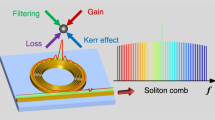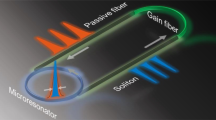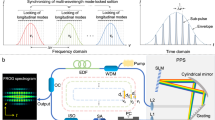Abstract
A coherently driven Kerr optical cavity is able to sustain dissipative temporal solitons, enabling all-optical data storage buffers and broadband frequency combs. Kerr solitons are balanced through an energy exchange with the pump field. Improving the pump-to-soliton energy conversion is of great importance for practical applications, but remains an outstanding challenge owing to a limited pump–soliton temporal overlap. Here we report the discovery of temporal solitons in mutually coupled cavities instead of a traditional single cavity. A pump recycling strategy is proposed, to greatly improve the power utilization efficiency. Using macroscale optical fibre-ring cavities, which share the same physical model as miniature microresonators, we demonstrate nearly 100% pump recycling and the ability to break the efficiency limit of a single cavity. This study could greatly extend the applications of temporal cavity solitons and provides an attractive platform for exploring the complex nonlinear dynamics in coupled cavity systems.
This is a preview of subscription content, access via your institution
Access options
Access Nature and 54 other Nature Portfolio journals
Get Nature+, our best-value online-access subscription
$29.99 / 30 days
cancel any time
Subscribe to this journal
Receive 12 print issues and online access
$209.00 per year
only $17.42 per issue
Buy this article
- Purchase on Springer Link
- Instant access to full article PDF
Prices may be subject to local taxes which are calculated during checkout






Similar content being viewed by others
Data availability
The data that support the plots within this paper and other findings of this study are available from the corresponding author on reasonable request.
References
Boardman, A. D. & Sukhorukov, A. P. Soliton-driven Photonics (Springer, 2001).
Liehr, A. W. Dissipative Solitons in Reaction Diffusion Systems (Springer, 2013).
Leo, F. et al. Temporal cavity solitons in one-dimensional Kerr media as bits in an all-optical buffer. Nat. Photon. 4, 471–476 (2010).
Del’Haye, P. et al. Optical frequency comb generation from a monolithic microresonator. Nature 450, 1214–1217 (2007).
Herr, T. et al. Temporal solitons in optical microresonators. Nat. Photon. 8, 145–152 (2014).
Jang, J. K., Erkintalo, M., Coen, S. & Murdoch, S. G. Temporal tweezing of light through the trapping and manipulation of temporal cavity solitons. Nat. Commun. 6, 7370 (2015).
Wang, Y. et al. Universal mechanism for the binding of temporal cavity solitons. Optica 4, 855–863 (2017).
Anderson, M. et al. Coexistence of multiple nonlinear states in a tristable passive Kerr resonator. Phys. Rev. X 7, 031031 (2017).
Weiner, A. M. Frequency combs: cavity solitons come of age. Nat. Photon. 11, 533–535 (2017).
Kippenberg, T. J., Gaeta, A. L., Lipson, M. & Gorodetsky, M. L. Dissipative Kerr solitons in optical microresonators. Science 361, eaan8083 (2018).
Saha, K. et al. Modelocking and femtosecond pulse generation in chip-based frequency combs. Opt. Express 21, 1335–1343 (2013).
Brasch, V. et al. Photonic chip-based optical frequency comb using soliton Cherenkov radiation. Science 351, 357–360 (2016).
Guo, H. et al. Universal dynamics and deterministic switching of dissipative Kerr solitons in optical microresonators. Nat. Phys. 13, 94–102 (2017).
Yang, Q. F., Yi, X., Yang, K. Y. & Vahala, K. J. Stokes solitons in optical microcavities. Nat. Phys. 13, 53–57 (2017).
Cole, D. C., Lamb, E. S., Del’Haye, P., Diddams, S. A. & Papp, S. B. Soliton crystals in Kerr resonators. Nat. Photon. 11, 671–676 (2017).
Obrzud, E., Lecomte, S. & Herr, T. Temporal solitons in microresonators driven by optical pulses. Nat. Photon. 11, 600–606 (2017).
Jang, J. K. et al. Synchronization of coupled optical microresonators. Nat. Photon. 12, 688–693 (2018).
Liang, W. et al. High spectral purity Kerr frequency comb radio frequency photonic oscillator. Nat. Commun. 6, 7957 (2015).
Suh, M.-G., Yang, Q.-F., Yang, K. Y., Yi, X. & Vahala, K. J. Microresonator soliton dual-comb spectroscopy. Science 354, 600–603 (2016).
Marin-Palomo, P. et al. Microresonator-based solitons for massively parallel coherent optical communications. Nature 546, 274–279 (2017).
Huang, S.-W. et al. Globally stable microresonator Turing pattern formation for coherent high-power THz radiation on-chip. Phys. Rev. X 7, 041002 (2017).
Trocha, P. et al. Ultrafast optical ranging using microresonator soliton frequency combs. Science 359, 887–891 (2018).
Suh, M.-G. & Vahala, K. J. Soliton microcomb range measurement. Science 359, 884–887 (2018).
Spencer, D. T. et al. An optical-frequency synthesizer using integrated photonics. Nature 557, 81–85 (2018).
Xue, X., Zheng, X., Zhou, B. & Weiner, A. M. Microresonator frequency combs for integrated microwave photonics. Photon. Technol. Lett. 30, 1814–1817 (2018).
Wu, J. et al. RF photonics: an optical micro-combs’ perspective. J. Sel. Top. Quantum Electron. 24, 6101020 (2018).
Bao, C. et al. Nonlinear conversion efficiency in Kerr frequency comb generation. Opt. Lett. 39, 6126–6129 (2014).
Xue, X., Wang, P.-H., Xuan, Y., Qi, M. & Weiner, A. M. Microresonator Kerr frequency combs with high conversion efficiency. Laser Photon. Rev. 11, 1600276 (2017).
Xue, X. et al. Mode-locked dark pulse Kerr combs in normal-dispersion microresonators. Nat. Photon. 9, 594–600 (2015).
The LIGO Scientific Collaboration and Virgo Collaboration. Observation of gravitational waves from a binary black hole merger. Phys. Rev. Lett. 116, 061102 (2016).
Mason, S. J. Feedback theory—further properties of signal flow graphs. Proc. IRE 44, 920–926 (1956).
Wang, P.-H. et al. Intracavity characterization of micro-comb generation in the single-soliton regime. Opt. Express 24, 10890–10897 (2016).
Grudinin, I. S. et al. High-contrast Kerr frequency combs. Optica 4, 434–437 (2017).
Haus, H. A. et al. in Optical Microcavities (ed. Vahala, K.) Ch.1 (World Scientific Publishing, 2004).
Coen, S. & Haelterman, M. Impedance-matched modulational instability laser for background-free pulse train generation in the THz range. Opt. Commun. 146, 339–346 (1998).
Kelly, S. M. J. Characteristic sideband instability of periodically amplified average soliton. Electron. Lett. 28, 806–807 (1992).
Matsko, A. B. et al. Optical Cherenkov radiation in overmoded microresonators. Opt. Lett. 41, 2907–2910 (2016).
Haelterman, M., Trillo, S. & Wabnitz, S. Dissipative modulation instability in a nonlinear dispersive ring cavity. Opt. Commun. 91, 401–407 (1992).
Coen, S., Randle, H. G., Sylvestre, T. & Erkintalo, M. Modeling of octave-spanning Kerr frequency combs using a generalized mean-field Lugiato–Lefever model. Opt. Lett. 38, 37–39 (2013).
Xue, X. et al. Second-harmonic-assisted four-wave mixing in chip-based microresonator frequency comb generation. Light Sci. Appl. 6, e16253 (2017).
Yi, X. et al. Single-mode dispersive waves and soliton microcomb dynamics. Nat. Commun. 8, 14869 (2017).
Xue, X. et al. Thermal tuning of Kerr frequency combs in silicon nitride microring resonators. Opt. Express 24, 687–698 (2016).
Joshi, C. et al. Thermally controlled comb generation and soliton modelocking in microresonators. Opt. Lett. 41, 2565–2568 (2016).
Yu, M., Okawachi, Y., Griffith, A. G., Lipson, M. & Gaeta, A. L. Mode-locked mid-infrared frequency combs in a silicon microresonator. Optica 3, 854–860 (2016).
Jung, H., Fong, K. Y., Xiong, C. & Tang, H. X. Electrical tuning and switching of an optical frequency comb generated in aluminum nitride microring resonators. Opt. Lett. 39, 84–87 (2014).
Zhang, M. et al. Electronically programmable photonic molecule. Nat. Photon. 13, 36–40 (2019).
Xue, X. et al. Normal-dispersion microcombs enabled by controllable mode interactions. Laser Photon. Rev. 9, L23–L28 (2015).
Miller, S. A. et al. Tunable frequency combs based on dual microring resonators. Opt. Express 23, 21527–21540 (2015).
Levy, J. S. et al. CMOS-compatible multiple-wavelength oscillator for on-chip optical interconnects. Nat. Photon. 4, 37–40 (2010).
Strickland, D. & Mourou, G. Compression of amplified chirped optical pulses. Opt. Commun. 56, 219–221 (1985).
Wang, Y. et al. Addressing temporal Kerr cavity solitons with a single pulse of intensity modulation. Opt. Lett. 43, 3192–3195 (2018).
Agrawal, G. P. Nonlinear Fibre Optics (Academic Press, 2001).
Acknowledgements
The authors thank A. M. Weiner, the late M. L. Gorodetsky and F. Leo for discussions, and S. Yang for providing the dispersion compensating fibre. This work was supported in part by the National Natural Science Foundation of China (grant numbers 61690191, 61690192 and 61420106003) and the Beijing Municipal Natural Science Foundation (grant number 4172029).
Author information
Authors and Affiliations
Contributions
X.X. conceived the idea, performed the experiments and performed the theoretical analysis. X.Z. and B.Z. helped to explain the results. All the authors were involved in discussions and preparation of the manuscript.
Corresponding author
Ethics declarations
Competing interests
The authors declare no competing interests.
Additional information
Publisher’s note: Springer Nature remains neutral with regard to jurisdictional claims in published maps and institutional affiliations.
Supplementary Information
Supplementary Information
This file contains more information about the work and Supplementary Figs. 1–9.
Rights and permissions
About this article
Cite this article
Xue, X., Zheng, X. & Zhou, B. Super-efficient temporal solitons in mutually coupled optical cavities. Nat. Photonics 13, 616–622 (2019). https://doi.org/10.1038/s41566-019-0436-0
Received:
Accepted:
Published:
Issue Date:
DOI: https://doi.org/10.1038/s41566-019-0436-0
This article is cited by
-
Integrated frequency-modulated optical parametric oscillator
Nature (2024)
-
Breaking the efficiency limitations of dissipative Kerr solitons using nonlinear couplers
Science China Physics, Mechanics & Astronomy (2024)
-
Non-equilibrium spectral phase transitions in coupled nonlinear optical resonators
Nature Physics (2023)
-
Soliton pulse pairs at multiple colours in normal dispersion microresonators
Nature Photonics (2023)
-
Surpassing the nonlinear conversion efficiency of soliton microcombs
Nature Photonics (2023)



